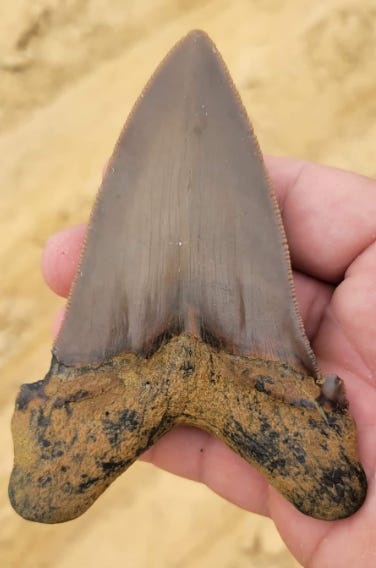An eight-year-old boy in Pennsylvania has discovered a giant tooth from prehistoric shark while fossil-hunting in South Carolina.
He found the giant tooth from shark that lived 22 million years ago while at Palmetto Fossil Excursions, an educational fossil-hunting expedition facility in Summerville where his parents, Justin and Janelle, took him and his brother, Collin.
Riley's father told Fox news that they've been searching for the treasures for many years even before their son could walk.
“We vacation in Myrtle Beach every summer, so from the time that Riley and his brother Collin could walk, we’ve been into searching for these treasures on the beach.”
The company confirmed Riley found a 4.75″ Angustiden tooth and shared pictures of the rarity in a Facebook post.
“Just to give perspective, any Angustiden over 4″ is the equivalent of finding a 6″ Meg, and an Angustiden at 4.75″ is the equivalent of finding a 6.5″ Megalodon tooth,” the post said. “Again, congratulations kiddo. Truly the find of a lifetime.”
On Monday, the boy's find continued to draw hundreds of likes and dozens of comments on Facebook.
In the comments section, some users congratulated the boy on the discovery.
“Meet a future paleontologist! Good job, young man!” one user wrote.
“Wow, that is one amazing fossil! Congratulations!” another commented.
Palmetto Fossil Excursions reportedly explained the significance of Riley's find because of its “species, size and condition.”
Otodus angustidens is a species of mega-toothed sharks that lived during the Oligocene and Micene epochs about 33 to 22 million years ago. The sharks are known to have grown to at least 31 feet long.
These sharks are related to the Otodus megalodon, another extinct shark with gigantic teeth.
Megalodons roamed the seas about 23 to 3.6 million years ago, could grow up to 67-feet long and had 250 thick teeth.
Riley's father said that his son is an avid fisherman who loves science and the outdoors.
“His collection is still in its early stages, so he’s keeping it for now, but who knows in time,” he said. “It would be nice for others to enjoy it, too”.


Comments
Post a Comment